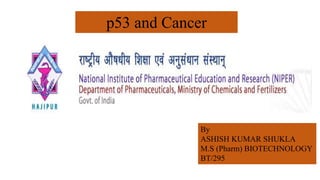p53 and cancer
•Download as PPTX, PDF•
2 likes•1,567 views
molecular biology
Report
Share
Report
Share

Recommended
More Related Content
What's hot
What's hot (20)
Protein folding, Heat shock proteins and disease involved with protein misfol...

Protein folding, Heat shock proteins and disease involved with protein misfol...
Viewers also liked
Viewers also liked (6)
THE GUARDIAN ANGEL OF GENOME P53 IN CANCER TREATMENT

THE GUARDIAN ANGEL OF GENOME P53 IN CANCER TREATMENT
Miologia – estudos dos músculos em ANATOMIA COMPARADA

Miologia – estudos dos músculos em ANATOMIA COMPARADA
Similar to p53 and cancer
Similar to p53 and cancer (20)
Cellular and molecular basis pathogenesis of cancer 

Cellular and molecular basis pathogenesis of cancer
Oncogenes, proto-oncogenes and tumor suppressor gene

Oncogenes, proto-oncogenes and tumor suppressor gene
Stopping and Starting Cancer Cell Cycle Weakens and Defeats Multiple Myeloma...

Stopping and Starting Cancer Cell Cycle Weakens and Defeats Multiple Myeloma...
More from Deepak Rohilla
More from Deepak Rohilla (10)
drug like property concepts in pharmaceutical design

drug like property concepts in pharmaceutical design
consensus superiority of the pharmacophore based alignment, over maximum comm...

consensus superiority of the pharmacophore based alignment, over maximum comm...
Recently uploaded
Recently uploaded (20)
TEST BANK For Radiologic Science for Technologists, 12th Edition by Stewart C...

TEST BANK For Radiologic Science for Technologists, 12th Edition by Stewart C...
Asymmetry in the atmosphere of the ultra-hot Jupiter WASP-76 b

Asymmetry in the atmosphere of the ultra-hot Jupiter WASP-76 b
Discovery of an Accretion Streamer and a Slow Wide-angle Outflow around FUOri...

Discovery of an Accretion Streamer and a Slow Wide-angle Outflow around FUOri...
High Profile 🔝 8250077686 📞 Call Girls Service in GTB Nagar🍑

High Profile 🔝 8250077686 📞 Call Girls Service in GTB Nagar🍑
Nightside clouds and disequilibrium chemistry on the hot Jupiter WASP-43b

Nightside clouds and disequilibrium chemistry on the hot Jupiter WASP-43b
Biogenic Sulfur Gases as Biosignatures on Temperate Sub-Neptune Waterworlds

Biogenic Sulfur Gases as Biosignatures on Temperate Sub-Neptune Waterworlds
Seismic Method Estimate velocity from seismic data.pptx

Seismic Method Estimate velocity from seismic data.pptx
Pulmonary drug delivery system M.pharm -2nd sem P'ceutics

Pulmonary drug delivery system M.pharm -2nd sem P'ceutics
FAIRSpectra - Enabling the FAIRification of Spectroscopy and Spectrometry

FAIRSpectra - Enabling the FAIRification of Spectroscopy and Spectrometry
p53 and cancer
- 1. p53 and Cancer By ASHISH KUMAR SHUKLA M.S (Pharm) BIOTECHNOLOGY BT/295
- 2. Cancer results from a series of molecular events that fundamentally alter the normal properties of cells. In cancer cells the normal control systems that prevent cell overgrowth and the invasion of other tissues are disabled. These altered cells divide and grow in the presence of signals that normally inhibit cell growth; therefore, they no longer require special signals to induce cell growth and division. As these cells grow they develop new characteristics, including changes in cell structure, decreased cell adhesion, and production of new enzymes. What Is Cancer?
- 3. INTRODUCTION •Tumor Suppressor •53 kDa protein •Encoded by TP53 gene •Regulates cell cycle
- 4. HISTORY The gene p53 was first discovered in 1979. A protein was identified in simian virus 40- transformed mouse cells (SV40) by immunoprecipitation with anti-T serum. This protein was called protein p53. It was thought that the reason why scientists called the protein p53 is that the molecular mass of this protein is 53kDa that is based on its migration in SDS gel. Later the molecular mass was proved to be wrong, and the correct molecular mass should be 43.7kDa because p53 contains a proline-rich region, and this region can reduce the migration of p53 in SDS gel. But the name ‘p53’ remained. During the 1980s, the protein p53 was believed to be involved in the cell cycle, as well as playing a role in DNA replication.
- 5. STRUCTURE
- 6. AMINO TERMINAL DOMAIN • Transactivation • Transcription factors – MDM2 PROLINE-RICH REGION • Stability CENTRAL CORE • DNA binding domain C-TERMINAL DOMAIN • Negative regulation
- 7. •It can activate DNA repair proteins when DNA has sustained damage. Thus, it may be an important factor in aging. •It can arrest growth by holding the cell cycle at the G1/S regulation point on DNA damage recognition (if it holds the cell here for long enough, the DNA repair proteins will have time to fix the damage and the cell will be allowed to continue the cell cycle). •It can initiate apoptosis (i.e., programmed cell death) if DNA damage proves to be irreparable.
- 8. Chemical Carcinogens • Direct acting vs. indirect • Indirect results from non-reactive chemicals being metabolized in liver to carcinogen • Oxidative reactions by p450 enzyme complexes rid body of fat soluble toxins • Active carcinogen binds to DNA and causes mutations (e.g., benzopyrene in cigarette smoke causes G to T transversions in DNA – causes mutations of p53 at codons 175, 248 and 273)
- 9. Initiators vs. Promoters • Initiators • Carcinogens that interact with and cause mutations in DNA • Promoters • Interact with cells to promote growth, block differentiation • Leads to additional permanent changes after initiator damage • Does not cause cancer by itself • No reliable test yet found to identify promoters
- 10. Radiation Mutations • Ultraviolet radiation • Ionizing radiation • Gamma- and X-rays • Particle radiation (alpha, beta) • Electromagnetic radiation • Power lines, cell phones, etc. • May act as promoter
- 11. Cancer Treatments • Surgery • Chemotherapy • Radiation therapy • Photodynamic therapy • “Magic bullets” • Angiogenesis inhibitors • Transplantation of hematopoietic stem cells • Whole body radiation to treat metastases • Gene therapy • Reintroduce p53 or other tumor suppressor genes • Must get into each and every cancer cell